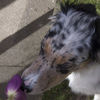And then he asked, “Did you see the giant ichneumons?”
Oct 15, 2019 06:47:32 #
Early last summer I was visiting a new park that was near my work. It was beautiful, featuring a sunny pond that was swarming with dragonflies, a lush meadow filled with wildflowers, and even a wetland area that was dotted with several dead trees. The dead trees were of timely interest since according to my calendar (I note important insect schedules in my calendar) giant ichneumon wasps from the genus Megarhyssa may be on them. So I spent considerable time inspecting the dead trees, since that is where these insects would be laying eggs. There are two species of these large parasitic wasps around here, but I had not seen one for several years. They use their extraordinarily long ovipositor to drill into dead wood, targeting the larva of another wasp known as the horntail. I had done these searches many times over the previous summers, and as before I once again came up ichneumon-less. So I returned to the pond to see about those dragonflies.
But presently I noticed that a man was walking toward me, clearly intent on seeing what I was up to. We struck up a conversation, and I told him about my interest in photographing insects. He seemed pretty knowledgeable about this sort of thing, and we had a prolonged discussion about dragonflies, mantidflies, and various other cool bugs. And then (out of the blue) he asked, “Did you see the giant ichneumons?” Just like that. I probably gawked a little, and stammered out that why, no…I had not seen any. And so he said he could show them to me. Of course! He led me across the field to a dead tree that I had overlooked (there were dense bushes around it), and there, spread all the way up the tree, was maybe a dozen of the wasps. Both species were present, and several males were among them! I thanked the man profusely and set to work with the camera.
In the first picture is Megarhyssa atrata , and the spindly wasp behind her is one of the male giant ichneumons. I am not sure what the males would be hoping to accomplish here since females seeking to lay eggs would have been mated. In fact, males are often seen swarming around young females even before they emerge from a tree trunk. The ovipositor of this female is deeply embedded into the tree. The long coils behind her are the supporting sheaths that are bent aside as the ovipositor was drilled in. She will lay an egg directly into the tunnel of the horntail wasp, and the hatched larva will search for its prey in total darkness.
After a time a female of the other species (M. macrurus ) came down from a group of ichneumons that were higher up. The next picture shows her hoisting her great ovipositor to begin drilling. Early in this process the ovipositor plus the sheath are partly enclosed in a supporting membrane which later retreats as she penetrates deeper. The sheath will meanwhile be bent aside. Over an extended time, other females came and went. I honestly could not count them since every time I tried to do so it seemed that I kept finding more!
In the next picture is a male M. macrurus. I don’t think I saw a male of the other species, although they are quite similar.
In the last picture I show a M. macrurus at the drill site that I was photographing. It was not often that I could photograph a single wasp without others cluttering up the scene.
From experience I knew that this orgy of horntail murder was far from over. Giant ichneumons will likely visit this same tree over several days, and they will repeatedly lay eggs in it. So I too was planning to return as soon as I could. Little did I know at the time that things were going to get pretty strange on the “ichneumon tree”.
Stay tuned!
But presently I noticed that a man was walking toward me, clearly intent on seeing what I was up to. We struck up a conversation, and I told him about my interest in photographing insects. He seemed pretty knowledgeable about this sort of thing, and we had a prolonged discussion about dragonflies, mantidflies, and various other cool bugs. And then (out of the blue) he asked, “Did you see the giant ichneumons?” Just like that. I probably gawked a little, and stammered out that why, no…I had not seen any. And so he said he could show them to me. Of course! He led me across the field to a dead tree that I had overlooked (there were dense bushes around it), and there, spread all the way up the tree, was maybe a dozen of the wasps. Both species were present, and several males were among them! I thanked the man profusely and set to work with the camera.
In the first picture is Megarhyssa atrata , and the spindly wasp behind her is one of the male giant ichneumons. I am not sure what the males would be hoping to accomplish here since females seeking to lay eggs would have been mated. In fact, males are often seen swarming around young females even before they emerge from a tree trunk. The ovipositor of this female is deeply embedded into the tree. The long coils behind her are the supporting sheaths that are bent aside as the ovipositor was drilled in. She will lay an egg directly into the tunnel of the horntail wasp, and the hatched larva will search for its prey in total darkness.
After a time a female of the other species (M. macrurus ) came down from a group of ichneumons that were higher up. The next picture shows her hoisting her great ovipositor to begin drilling. Early in this process the ovipositor plus the sheath are partly enclosed in a supporting membrane which later retreats as she penetrates deeper. The sheath will meanwhile be bent aside. Over an extended time, other females came and went. I honestly could not count them since every time I tried to do so it seemed that I kept finding more!
In the next picture is a male M. macrurus. I don’t think I saw a male of the other species, although they are quite similar.
In the last picture I show a M. macrurus at the drill site that I was photographing. It was not often that I could photograph a single wasp without others cluttering up the scene.
From experience I knew that this orgy of horntail murder was far from over. Giant ichneumons will likely visit this same tree over several days, and they will repeatedly lay eggs in it. So I too was planning to return as soon as I could. Little did I know at the time that things were going to get pretty strange on the “ichneumon tree”.
Stay tuned!
M. atrata
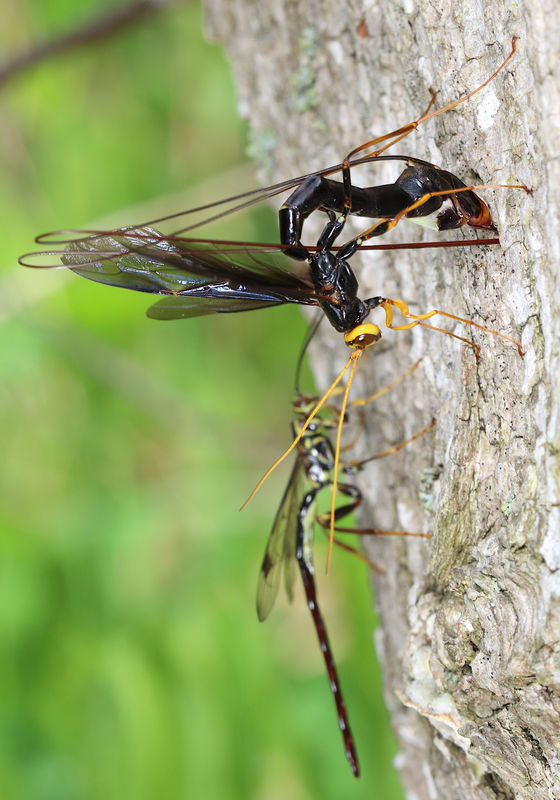
(Download)
M. atrata and M. macrurus
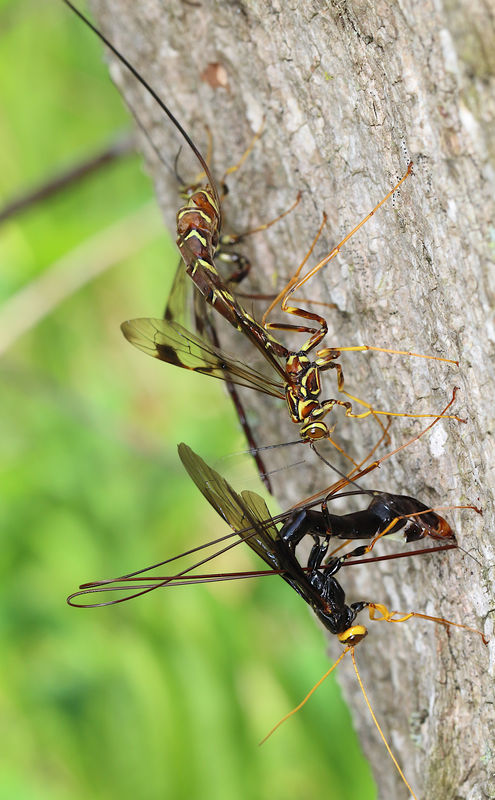
(Download)
Raising the ovipositor
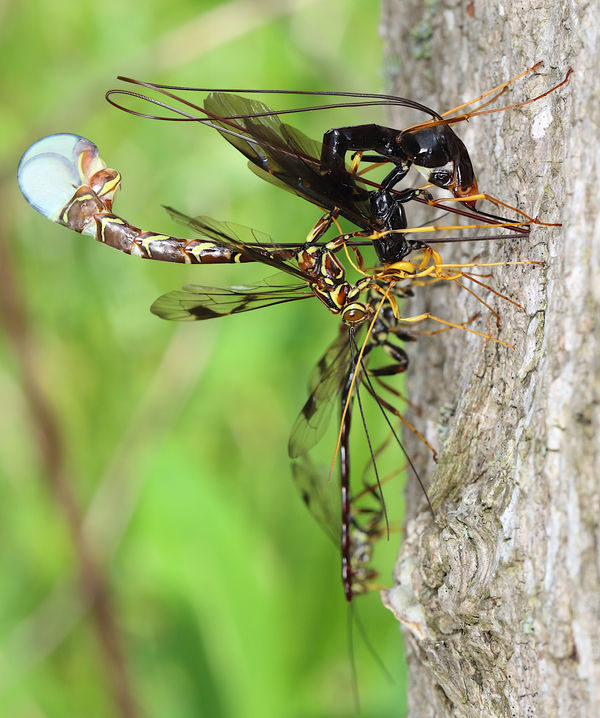
(Download)
Male M. macrurus
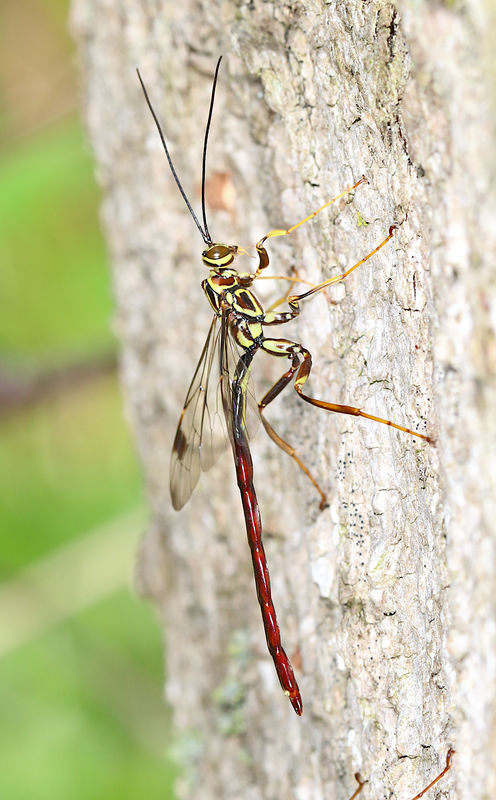
(Download)
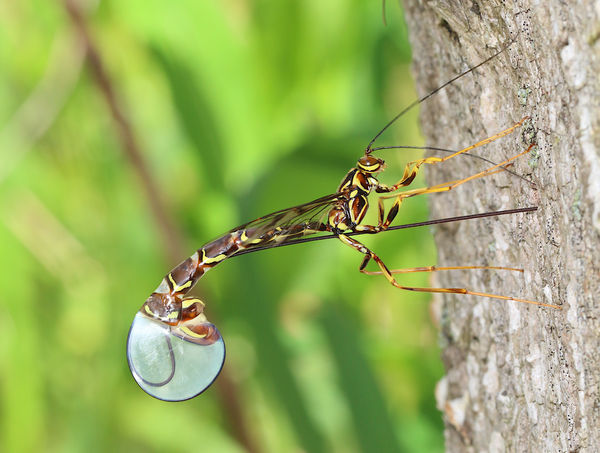
(Download)
Oct 15, 2019 06:52:35 #
Brilliant shots, have never seen one before... Lucky you met the man with the info on where they were...
Oct 15, 2019 07:04:42 #
Whilst I am not a fan of parasitic creatures I find the Ichneumon wasps quite handsome. These are good shots and I look forward to what happens next on the Ichneumon tree.
Oct 15, 2019 07:14:10 #
Oct 15, 2019 08:19:08 #
Fascinating narrative, and terrific photographs! Looking forward to more. Thank you for taking the time to write!
Oct 15, 2019 09:29:34 #
Oct 15, 2019 11:22:18 #
Oct 15, 2019 14:18:28 #
I did not notice before, but if you look closely you can see in the third picture that the brown and yellow female is straddling the black female, and she is literally drilling into the other females' hole! She's jumping her claim!
Oct 15, 2019 14:31:52 #
Really great photos and narrative. I'm looking forward to the next installment.
Oct 15, 2019 15:30:22 #
Oct 15, 2019 19:11:08 #
Mark Sturtevant wrote:
Early last summer I was visiting a new park that w... (show quote)
Those are gorgeous, both the insects and the shots.
I have a ways to go, proving, to me, since I use the same basic equipment with different results, that it is the photographer that
elevates the work to art.
I have never been able to find these at ground level. I used a climbing deer stand to get to large branches in a near tree to observe.
I think the largest insect in total length.
I have a mounted atrata that is near 6.5 lnches.
Bill
Oct 16, 2019 09:46:07 #
Oct 16, 2019 10:34:51 #
Oct 16, 2019 11:12:18 #
Oct 16, 2019 13:02:59 #
If you want to reply, then register here. Registration is free and your account is created instantly, so you can post right away.

